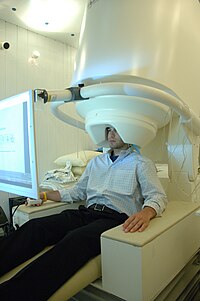
Photo from wikipedia
Abstract Animals and humans rapidly detect specific features of sounds, but the time courses of the underlying neural response for different stimulus categories is largely unknown. Furthermore, the intricate functional… Click to show full abstract
Abstract Animals and humans rapidly detect specific features of sounds, but the time courses of the underlying neural response for different stimulus categories is largely unknown. Furthermore, the intricate functional organization of auditory information processing pathways is poorly understood. Here, we computed neuronal response latencies from simultaneously recorded spike trains and local field potentials (LFPs) along the first two stages of cortical sound processing, primary auditory cortex (A1) and lateral belt (LB), of awake, behaving macaques. Two types of response latencies were measured for spike trains as well as LFPs: (1) onset latency, time-locked to onset of external auditory stimuli; and (2) selection latency, time taken from stimulus onset to a selective response to a specific stimulus category. Trial-by-trial LFP onset latencies predominantly reflecting synaptic input arrival typically preceded spike onset latencies, assumed to be representative of neuronal output indicating that both areas may receive input environmental signals and relay the information to the next stage. In A1, simple sounds, such as pure tones (PTs), yielded shorter spike onset latencies compared to complex sounds, such as monkey vocalizations (“Coos”). This trend was reversed in LB, indicating a hierarchical functional organization of auditory cortex in the macaque. LFP selection latencies in A1 were always shorter than those in LB for both PT and Coo reflecting the serial arrival of stimulus-specific information in these areas. Thus, chronometry on spike-LFP signals revealed some of the effective neural circuitry underlying complex sound discrimination.
Journal Title: eNeuro
Year Published: 2018
Link to full text (if available)
Share on Social Media: Sign Up to like & get
recommendations!